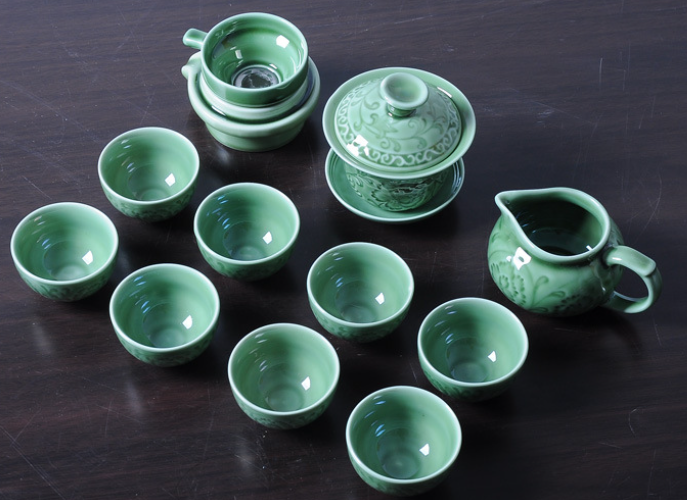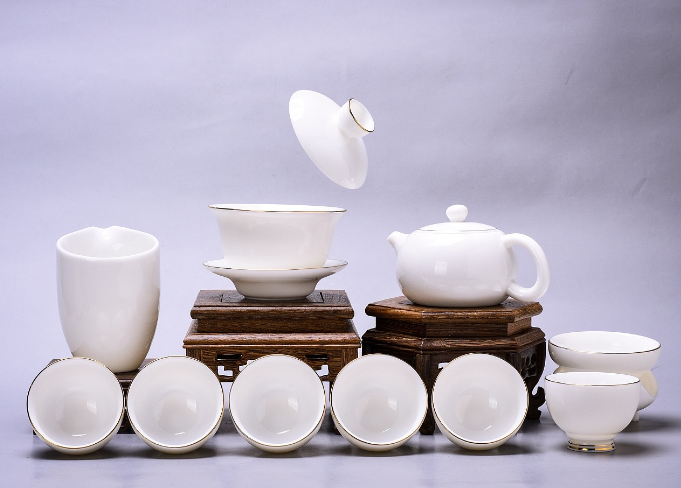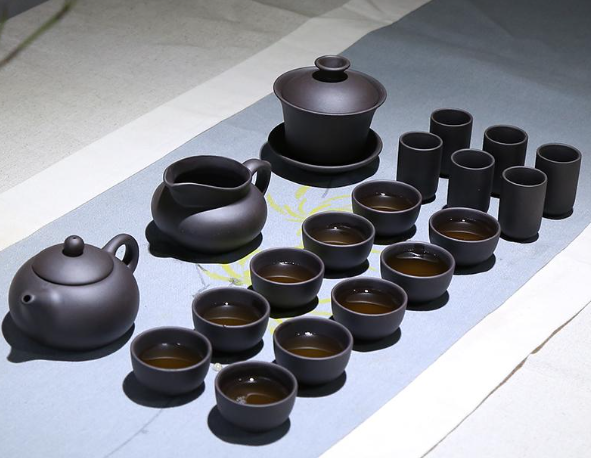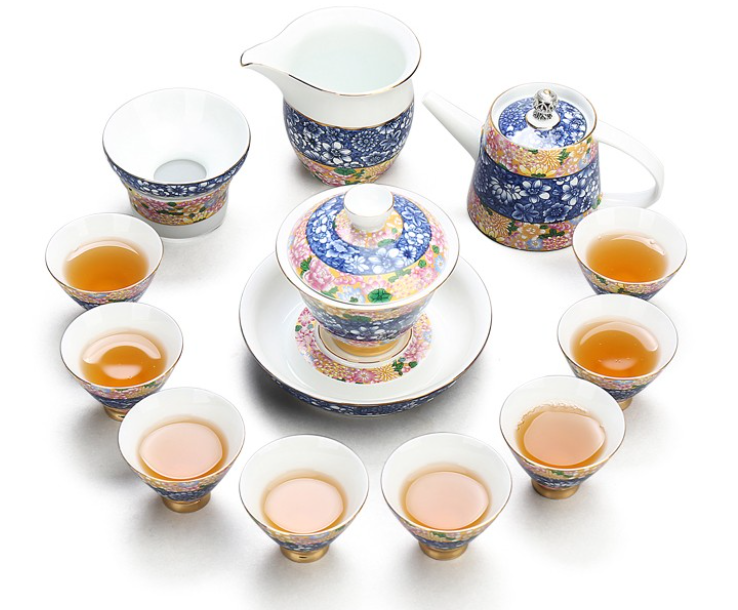There are many varieties of porcelain tea sets, the main ones are: celadon tea sets, white porcelain tea sets, black porcelain tea sets and colored porcelain sets. These tea utensils have had a glorious page in the history of the development of Chinese tea culture.
Celadon tea set

Celadon tea set with quality xxx produced in Zhejiang. As early as the Eastern Han Dynasty, the production of celadon with pure color and transparent luminescence began. The Yue kiln, Wu kiln and Ou kiln in Zhejiang in the Jin Dynasty have reached a considerable scale. In the Song Dynasty, as one of the five famous kilns at that time, the celadon tea set produced by Zhejiang Longquan Ge Kiln had reached its peak and was exported to all over the world. In the Ming Dynasty, celadon tea sets were more famous for their delicate texture, dignified shape, green glaze, and elegant patterns. At the end of the 16th century, Longquan celadon was exported to France, causing a sensation throughout France, and people compared it with the beautiful green robe of the heroine Xue Latong in the famous drama "Shepherdess" that was popular in Europe at that time, and called Longquan celadon "Xue Laton" as a rare treasure. Contemporary times, Zhejiang Longquan celadon tea sets have new developments, and new products continue to come out. In addition to the many advantages of porcelain tea sets, this tea set is used to brew green tea because of its green color, which is more beneficial to the beauty of soup. However, using it to brew black tea, white tea, yellow tea, and black tea is easy to make the tea soup lose its original appearance, which seems to be inadequate.
White porcelain tea set

White porcelain tea has the characteristics of dense and transparent billet, high glazed and pottery fire, no water absorption, clear sound and long rhyme. Because of its white color, it can reflect the color of the tea soup, moderate heat transfer and heat preservation performance, plus colorful and different shapes, which can be called a treasure in tea drinking vessels. As early as the Tang Dynasty, the white porcelain utensils produced by Xingyao in Hebei Province were "universally used by nobles and nobles in the world." Bai Juyi of the Tang Dynasty also wrote poems praising the white porcelain tea bowls produced in Dayi, Sichuan. In the Yuan Dynasty, white porcelain tea sets in Jingdezhen, Jiangxi Province have been exported abroad. Today, white porcelain tea sets are even more renewed. This white-glazed tea set is suitable for brewing all kinds of tea. In addition, the white porcelain tea set is exquisite in shape and elegantly decorated, and its outer wall is mostly painted with mountains and rivers, seasonal flowers and plants, birds and animals, character stories, or decorated with celebrity calligraphy, and has quite artistic appreciation value, so it is the most commonly used.
Black porcelain tea set

Black porcelain tea sets, began in the late Tang Dynasty, flourished in the Song, continued in the Yuan, and declined in the Ming and Qing dynasties, this is because since the beginning of the Song xxx, the method of drinking tea
It has gradually changed from the Sencha method in the Tang Dynasty to the method of ordering tea, and the popular fighting tea in the Song Dynasty has created conditions for the rise of black porcelain tea sets.
The Song people measured the effect of fighting tea, looked at the color and uniformity of the tea noodle soup, and put "bright white" first; Second, look at the presence or absence of water marks at the junction of the soup flower and the tea lamp and sooner or later appear, with "no water marks on the lamp" as the top. Cai Xiang, who was the third envoy at the time, made it very clear in his "Tea Record":
"It is excellent to see that his face is bright white and has no water marks; In the construction of the fight test, the first one with the water mark is the loser, and the durable one wins. And the black porcelain tea set,
As Song Dynasty Zhu Mu said in "Fang Yu Shengyan", "Brown is white, into the black lamp, its marks are easy to verify". Therefore, the black porcelain tea lamp of the Song Dynasty became the largest variety of porcelain tea sets. Fujian Jianyao, Jiangxi Jizhou Kiln, Shanxi Yuci Kiln, etc., all produce black porcelain tea sets in large quantities, becoming the main production area of black porcelain tea sets. Among the kilns of black porcelain tea sets, the "Jianzhen" produced by Jianyao is the most praised. Cai Xiang's "Tea Record" said this:
"The creator of Jian'an... Most important. Those who come from elsewhere, thin or purple, are not as good as either. "The unique formula makes the glaze appear rabbit stripes, partridge spots, and sun spots during the firing process, once the tea soup is in the lamp,
It can radiate colorful bits of brilliance, which increases the interest of fighting tea. At the beginning of the Ming Dynasty, because the method of "cooking point" was different from that of the Song Dynasty, black porcelain building lamps "seemed to be unsuitable", only as a "preparation for one".
Colored porcelain tea set

There are many varieties of colorful tea sets, among which blue and white porcelain tea sets are the most eye-catching. Blue and white porcelain tea set, in fact, refers to the use of cobalt oxide as the coloring agent, directly depicting the pattern on the porcelain tire, and then coating a layer of transparent glaze, and then reducing and firing at a high temperature of about 1300 °C in the kiln.
However, the understanding of "blue" in the color of "blue flower" is also different in ancient and modern times. The ancients collectively referred to black, blue, blue, green and other colors as "green", so the meaning of "blue flower" is broader than that of today's people. It is characterized by:
The pattern blue and white reflect each other, which is pleasing to the eye; The colors are elegant and charming, and there is a flashy color
The power of glamour. In addition, the glaze on the color material looks moist and bright, which adds to the charm of blue and white tea sets.
It was not until the middle and late Yuan Dynasty that blue-and-white porcelain tea sets began to be produced in batches, especially Jingdezhen, which became the main production place of blue-and-white porcelain tea sets in China. Due to the high level of blue and white porcelain tea set painting technology, especially the application of traditional Chinese painting techniques to porcelain, this can also be said to be a major achievement of Yuan Dynasty painting. After the Yuan Dynasty, in addition to the production of blue and white tea sets in Jingdezhen, there were also a small number of blue and white porcelain tea sets produced in Yuxi, Jianshui in Yunnan, Jiangshan and other places in Zhejiang, but whether it was glaze color, tire quality, ornamentation, painting skills, they could not be compared with the blue and white porcelain tea sets produced in Jingdezhen at the same time. Ming Dynasty, Jingdezhen production of blue and white porcelain tea sets, such as teapots, tea cups, tea lamps, more and more varieties of colors, more and more refined quality, whether it is the shape, shape, ornamentation, etc. are the top of the country, become other production of blue and white tea set kiln imitation object, Qing Dynasty, especially Kangxi, Yongzheng, Qianlong period, blue and white porcelain tea set in the history of ancient ceramics development, and entered a historical peak, it surpassed the previous dynasty, affecting future generations. The blue and white porcelain utensils fired during the Kangxi Dynasty are known as "the best of the Qing Dynasty" in history.



